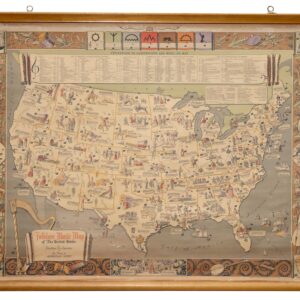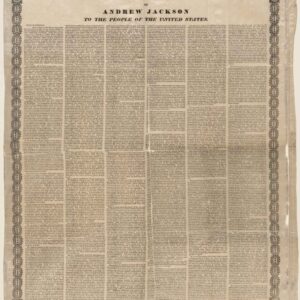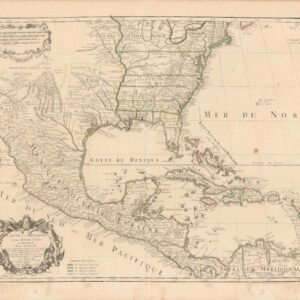A pioneering map of the most inhabited parts of Wisconsin, based on the most recent surveys.
Sectional Map of Wisconsin.
Out of stock
Description
The scarce 1855 edition.
In many ways, Silas Chapman’s first 1853 sectional map of Wisconsin marks the beginning of the new state’s cartographic record. Chapman compiled this map based on surveys of the areas south and east of the Fox and Wisconsin Rivers. This southern focus was reasonably justified in that the majority of the state’s inhabitants lived here rather than in the northern and western parts of the state. But things developed quickly in America during the mid-19th century, and Wisconsin was no exception to this rule. Within a few years, settlement and development had expanded so dramatically across the state that new and revised maps were necessary.
Chapman issued a new edition of his sectional map in 1855, which not only was more comprehensive in its coverage but carefully revised information adopted from the first map. This is the state that Neatline offers here. The revisions were partly due to an insistence on accuracy and reliability, but Chapman was motivated to secure his map the position as the seminal cartographic representation of Wisconsin. The 1855 edition focuses on the southern two-thirds of the state, with the northernmost county depicted on our map being Polk.
At the time, the need for swift and recurring revisions was obvious. The following year, Chapman published two new maps of Wisconsin: a detailed map of the more inhabited southern parts, such as ours, and a full-scale wall map of the entire state. This constant need for revised new compilations reflects the pace with which Wisconsin was being developed in the decade following statehood (1848). When comparing the three maps of the more inhabited southern part of the state, one area in which the development immediately stands out is the scope of railway systems. While these were confined to the southeast quadrant of the state in the original 1853 publication, three years later, this infrastructure had been dramatically expanded to include many more settlements and to cover the entire state. Neatline’s example of the intermediary 1855 state captures this expansion mid-process.
The map is generally very detailed, showing railroads, plank roads, mines, cities and towns, counties, lakes, marshes, rivers, whitewater areas, military posts, and portage points. The entire thing has been overlaid with a township grid and red-bordered county divisions. It is also one of the earliest cartographic representations of America’s easternmost Indian Reservations.
Entering into our map from the upper right corner is Green Bay, the physiographic inland extension of which is Lake Winnebago. Just to the west of Green Bay, we find one of the map’s most telling features: the Reservation of the Algonquin-speaking Menominee tribe (Menomonee). This reservation was brand new when Chapman compiled Neatline’s edition of the map, which was founded only a year earlier through a treaty with the United States Government.
The Menominee Tribe had fought alongside the British in the American Revolution and had since then shown considerable apprehension towards the territorial ambitions of these new United States. The Menominee Tribe produced several formidable warriors opposing American annexation of tribal lands, the most historically prominent of which was the coalition leader Tecumseh. The Oneida Reservation is also shown on the map, though this had existed for more than a decade when Chapman began his work. The Oneida Reserve was created in 1838 for the exiled members of the Oneida Tribe of New York.
Silas Chapman’s maps of early Wisconsin are not just examples of pioneering American cartography but constitute essential tools for understanding the colonization and history of the Upper Midwest during the eventful 19th century. Based in Wisconsin, Chapman was at the center of a drama that unfolded across Minnesota, Wisconsin, Iowa, and the Dakotas. His efforts to map his new home state of Wisconsin elevated him to the region’s leading cartographic authority in the tumultuous decades following statehood.
Census
Chapman’s sectional map of Wisconsin exists in a number of editions, with 1853, 1855, 1856, and 1857 being the most known and influential. When searching for institutional examples of Chapman’s Wisconsin maps, the OCLC lists quite a few holdings from these different years. Narrowing the search to focus on the 1855 edition, we note the presence of examples in a number of key American institutions such as the libraries at Harvard, Brown, Yale, Michigan, Chicago (68946678) and the David Rumsey Collection at Stanford (953568861). It is also held by the New York Public Library, The Newberry, Wisconsin Historical Society (68946678), and the Huntington Library (81867043).
Editions of the Chapman map come to market at regular intervals, but most of these are the later 1856 and 1857 states. The earlier 1853 and 1855 states are increasingly rare.
Cartographer(s):
Silas Chapman (1813-1899) was a prominent midwestern map publisher who originally came from Massachusetts. His firm was very active during the formative years of the Upper Midwest (1850-70), publishing many wall and pocket maps of Wisconsin, Minnesota, and Iowa.
Condition Description
Sold with original covers.
Very good. Toning and wear along fold lines. Loss at fold intersections professionally repaired on verso. Sporadic areas of uneven toning and soiling.
References



